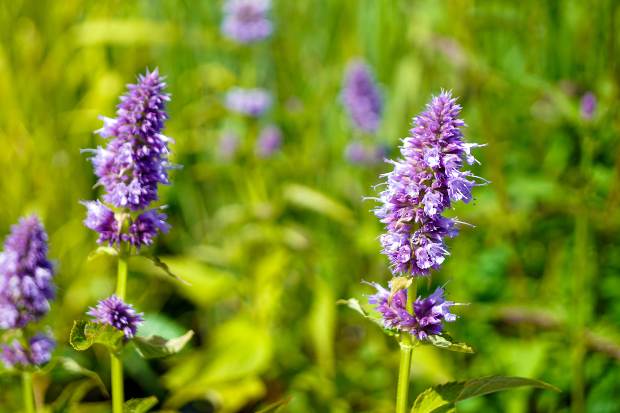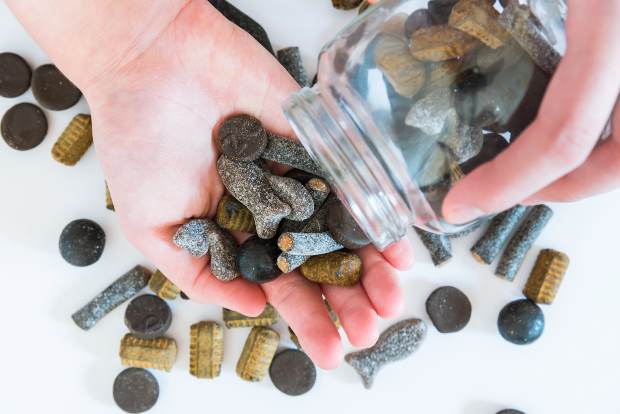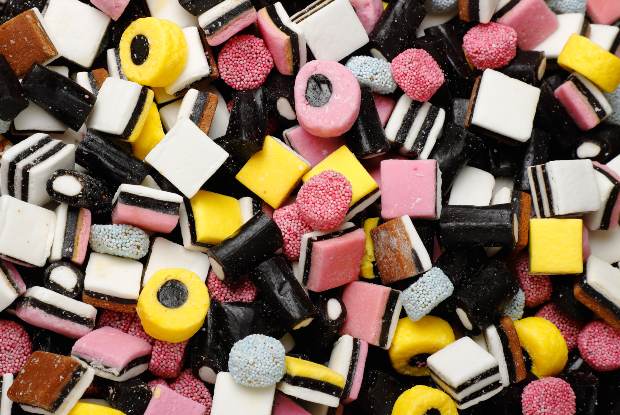Liquorice lovers from around the world have enjoyed their favourite, either sweet, salty, bitter or flavoured, over the ages. This ‘black gold’ is so popular that 12 April is celebrated as National Liquorice Day and yearly festivals are held in Pontefract in the UK, Stockholm (Lakritsfestivalen), Copenhagen (Lakridsfestival) and the Lakritsi- & Salmiakkifestivaalit in Finland. Today it is best known as a confectionery product, but the sweet taste is also used to mask unpleasant-tasting medicines and the extracts are used in the tobacco, cosmetic and brewing industries, as well as in liquor making to flavour both alcoholic and non-alcoholic drinks.
The liquorice plant
The unmistakable, unique bittersweet taste comes from anethole – this is a sweet-tasting compound found in anise and fennel, although the plants aren’t related. Even if there are over a dozen varieties of liquorice, each with their own particular flavour according to the variety, the plant is known by its Latin name Liquiritia officinalis. The shoots and leaves are edible, but the roots are most important as they contain glycyrrhizin, which is 50 times sweeter than sugar. But the sweetness is different from sugar, being less instant, sharp and longer lasting. The quality and sweetness of the root depends on a six to 14% glycyrrhizin content. Liquorice also contains bitter substances, which partly mask the sweet taste, as well as vitamins E, B1, B2, B3, B6, B9, biotin, lecithin, manganese, niacin, pantothenic acid, phosphorus, zinc and other trace elements.

Liquorice can be an ornamental plant in your garden with light green foliage and blue or pale violet and white flowers appearing in late summer. But don’t confuse true liquorice with other plants with common names like ‘liquorice plant’, which is known as Helichrysum petiolare. Cultivation can be difficult as the liquorice shrub has the traits of an intrusive weed and needs careful management. The sandy soil around Pontefract in West Yorkshire was believed to be particularly suitable for cultivation, as the cold English climate prevented the plants from flowering, which made the liquorice roots even sweeter. In England it takes five years to harvest liquorice, while in most of Europe it takes only three to four years to mature. Otherwise the plant is prevented from flowering and both the downward-running roots and runners are harvested, after the branches are trimmed off. Until the late 19th century, Spain grew most of the world’s liquorice and it was believed to have been brought to England in the Middle Ages by Spanish monks. Today cultivation on a commercial scale is done in Turkey, Iraq, Spain and Italy.
‘Black liquorice’ describes in general black-coloured confectionery flavoured with liquorice extract (even anise for cheaper commercial versions), made in the form of chewy ropes, twists or tubes mostly. While ‘red liquorice’ is a favourite more in Australia and the USA, it doesn’t contain any liquorice extract and is a fruit-flavoured chewy confectionery only.
Liquorice production
The liquorice roots harvested are washed, cut into smaller pieces, covered and then dried naturally for four to six months to reduce the moisture content from 50% to 10%. The dark outer layers of the roots are peeled off before drying and the peeled yellow liquorice is also used for pharmaceutical purposes. These cleaned, dried roots are shredded in ten-times-their-volume hot water of 60°C by centrifuge in machines. The resultant liquid is left to settle and decanted into evaporating pans to be concentrated at a controlled temperature. This extract is transferred to steam-heated kettles with revolving scrapers, but the evaporation continues until the extract is about 75% of its volume with 18 to 25% moisture with a pulp formed. The pulp is again filtered and concentrated, and poured into blocks while hot. These blocks are left to cool and dry to a thick, black tar-like mass with an overpowering flavour and called block liquorice. Other extraction methods involve grinding the woody roots to a yellowish-brown powder that can either be used as it is or mixed with water.
Liquorice through the ages
Liquorice roots, twigs, leaves and flowers were used in Chinese medicine as early as 2800BC to assist in gastrointestinal absorption and boost the effects of other herbs. A large quantity – well preserved – was found in the tomb of pharaoh Tutankhamun from 1350BC in Egypt. Even today Egyptians drink erk sous, made from liquorice root, sold by street vendors in Cairo, which is believed to strengthen the immune system. Even the Greek philosopher Theophrastus of Lesbos was known to use it in 300BC to treat asthma, dry coughs and chest complaints.

Throughout history, liquorice roots were chewed to reduce thirst when water was scarce. Chewing the root until all the juice is extracted and it leaves a bitter taste acts on the salivary glands to remove thirst. Glycyrrhizin is the active principle in the root that promotes sodium and water retention, reducing the sensation of thirst. The army of Alexander the Great used this method during long marches. Hannibal fed his elephants liquorice root when he took them over the Alps and it is noted that Arabs gave it to their camels on the desert camel trains.
During the 13th century, liquorice extract combined with honey was used as medicine in Europe for coughs and sore throats, and by the 17th century it was still prescribed for chest complaints. Only by 1750 did liquorice start to be seen as a confectionery in England, France and Italy.
Types of liquorice around the world
All over the world each nationality has its own favourite type of liquorice. In the Netherlands the Dutch are the world’s largest consumers of drop liquorice in different types and flavours like mint, menthol or honey. Drop sweet liquorice and Drop Zout liquorice are soft and sweet, soft and salty, hard and sweet or hard and salty. In Britain the liquorice confectionery enjoyed includes comfits and torpedoes (liquorice encased in a coloured hard sugar shell), liquorice allsorts (these black liquorice sweets sandwiched in coloured sugar paste are a known favourite in South Africa as well), pipes, twists, wands, pinwheels and chewy stamped Pontefract cakes. While in Italy, unsweetened liquorice or liquirizia is consumed in the form of sticks or small black pieces made from 100% pure liquorice extract, with a bitter and intense flavour. Other favourites there include telephone cables (long, thin strips of sweet liquorice), Senatori alla Violetta (violet-flavoured liquorice pastilles), Sassolin (sugar-coated strong liquorice that looks like small pebbles) and chewy berry-shaped Morette all’arancia flavoured with orange juice.
Scandinavia is the ultimate destination for salty liquorice lovers, with liquorice-only shops dotted in the cities of Denmark, Sweden and Norway. Anything liquorice is sold here – from liquorice chips, liquorice wafer biscuits, liquorice ice cream and of course all types of liquorice sweets. Salty liquorice, especially the type found in these regions, can be a shock to your palate: a sharp, sour, pungent flavour that keeps a tingle on your tongue. It is such a strange taste to get used to that it even got a place in the Disgusting Food Museum in Malmö, Sweden. Known as salmiakk or saltlakrits in Norwegian and saltlakrids in Icelandic, in Finland this salty liquorice is called salmiakki. It is also a popular destination for Lakkris Kulur, which are chocolate-covered black liquorice balls, which give the sensation of a crunchy outer chocolate shell with a smooth and chewy liquorice centre.

A cook’s guide to liquorice
The unique flavour of liquorice makes it a cooking ingredient in both sweet and savoury dishes, but remember that although anise has a similar flavour to liquorice due to its anethole content, the Pimpinella anisum plant is a member of the parsley family and not related to liquorice. It is a white flowered herb with brown aniseeds with a liquorice taste, used in liqueurs or to enhance flavours.
Liquorice roots are the most important part of the liquorice plant and resemble hard woody twigs, which can exude their strong aroma without heating. It can simply be stored in a jar of sugar or salt to give off its flavour, or impart more flavour when steeped into hot liquids like teas, syrups, sauces, custards and even stews. Liquorice powder is made by steaming and pressing the roots and then grinding them into a powder. This useful addition to your spice cupboard can be used to season drinks such as milk or coffee, added to barbeque rubs or sprinkled on oats, desserts and sweet sauces (liquorice cheesecake or in malva pudding) or ice cream. Sweet liquorice syrup is made from a combination of aniseed, cane sugar and liquorice, while salty liquorice syrup is made from cane sugar, ammonium chloride, liquorice and a touch of aniseed. Liquorice essence is made from a concentrated natural liquorice extract and the strength varies according to the brand. Hard liquorice, with a more intense, slightly bitter flavour than the softer sticks, can be used in cooking by dissolving it in a liquid.
Liquorice is a versatile ingredient and can give depth of flavour to savoury dishes like risottos, meat, fish and even salads, when combined with other spices. The bold taste can give a caramel-type flavour to cakes, puddings, desserts and ice creams, and remember that it has a natural affinity with chocolate. Two dried liquorice roots can flavour a jar of sugar in the same way as vanilla pods. Liquorice drinks, whether a hot infusion or cold beverage, are both medicinal and thirst-quenching.
Cooking inspiration can be found from Morocco, India and the Far East. In Morocco it is part of the popular spice blend of ras el hanout and added to snail and octopus dishes for flavour. Asian cooking uses liquorice powder in five-spice powder, soy sauce, marinades and sauces. In Indian cuisine the ground powder of jethimadh is used and dried liquorice root chewed as a mouth-freshener after meals.
ALSO READ: Is MSG really that bad? 4 facts that will change your mind















